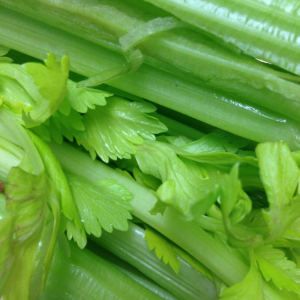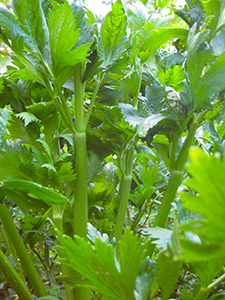
100g raw celery contains 16 calories.
76% carbs, 10% fat, 18% protein
Now just a crispy dipper for holiday part platters, celery was once the symbol of an ancient death cult and the mascot of a powerful city. What happened?
History:
Celery is native to the earliest agricultural hotspots around the Mediterranean where it grows wild in
wetlands and boggy areas. In Homer’s Iliad, wild celery was reported growing in the marshy areas around Troy. Ancient forms of celery were leafy and a dark green color, and were often strung on burial garlands. The most ancient example of dried celery leaves were found in the tomb of the Egyptian Pharaoh Tutankhamun, who died in 1323 B.C. Celery became so associated with death that a common saying for kicking the bucket in Greece was, “He now has need of nothing but celery.”
Given the association with death, celery might seem like a strange mascot for one of the richest and most powerful cities in the ancient world. In 628 B.C. the Greeks founded Selinunte, which translates as “Celery City,” and used impressions of the leaf to mark its coins. Today Lonely Planet ranks the ruins of Celery City as “some of the most impressive of the ancient Greek world.”
A more recent celery city was Michigan’s Kalamazoo, which earned the nickname “Celeryville” in the late 1800’s when Dutch immigrants in wooden shoes began cultivating the mudflats with celery fields. At the zenith of the celery craze, Kalamazoo’s railway yards packed fresh celery for all of America and its salesmen touted celery’s curative properties for everything from increasing libido to curing vague ailments like “nervous disease.” It couldn’t last; California jumped on the celery bandwagon and by 1985, only one celery farmer was left in Kalamazoo. Today 85% of all celery in the United States is grown along the coast of California from San Luis Obispo north to Monterey.
How Celery Is Grown:

Celery is still a wetlands plant that needs a lot of water to provide the high moisture content and juicy crispness we love. Traditionally, celery was planted in deep trenches (1 foot deep) and covered with dirt in a process called “banking,” which protects the stalks from the sun and keeps them sweet and pale.
However, piling soil over the plants left dirt in between the stalks. Today, celery growers cover the plants with cardboard or thick paper, which provides the darkness but keeps the plants clean. The drawback is that the tender, juicy stalks are now exposed to the ravages of insects, necessitating the use of more pesticides.
At one time, celery was primarily harvested in the winter and early spring, but is now available all year.
A Note on Pesticides: over 60 different pesticides are used today on commercial celery, earning its place as #1 on the EWG’s “Dirty Dozen” food list.
A Few Varieties:
Botanically speaking, there are three different forms of celery that all belong to the same species: Apium graveolens. The celery most of us know is the long-stalked, crunchy sticks with tufts of yellow-green leaves, (var. dulce), but there’s also celeriac, a huge knobby white root ball with little stalks attached like a monk’s tonsure (var. rapaceum), and a leafy version with slim stalks (var. secalinum) that is common today in Asian cuisine and is probably most like what the ancient Greeks consumed and the Romans ground into pesto. All three varieties are noted in Carl Linnaeus’s 1735 taxonomy, Systema Naturae.
The familiar long-stalked version is the one primarily cultivated today, and most commercial varieties like Command, Mission, and Challenger have been bred to be resistant to Fusarium disease. However, there are a few heirloom varieties you may want to look for at your local farmers’ market or plant in your own backyard:
Golden Heart: this is the celery of Kalamazoo, which was introduced in 1886 from France because its stems grow yellow-white without needing to be covered or banked. In fact, until the 1950’s most Americans thought of celery as a yellow vegetable, not green.
Red Giant: Introduced to America in 1841, this unique celery has reddish pink stalks that are darkest red near the soil and green at the leafy tips. This distinct coloration makes it a beautiful choice for the Holidays. Red celeries can be found today at some farmers markets.

Articles and Recipes:
- Celery: More Than Worth Its Salt by Dr. Graham
- Fast, Fun, and Phenomenally Easy Recipes by Dr. Graham
- Gazpacho Soup Recipe
- Brazil Nut Salad Recipe by Kevin Cosmo
- Cauliflower Made Delectable Recipe by Dr. Graham
- Cheezy Shephard’s Pie Recipe by Chris Kendall and Ashley Clark
- Rainbow Kabobs : Recipe Served at Culinary Skills Week 2011 by Student: Katie Rushworth
- Post-Training Smoothie Recipe by Janie Gardener
- Sweet-n-Savory Burritos Recipe by Dr. Graham and Chef Katy Craine
Retreats:
Cultivate Your Inner Chef |
Practical Skills To Thrive |
Books:
Simply Delicious Fall Retreat Menu |
Simply Delicious SALADS and SLAWS |
Simply Delicious DESSERTS |
Simply Delicious SOUPS |







